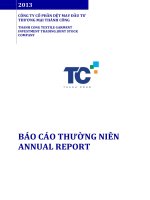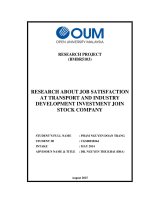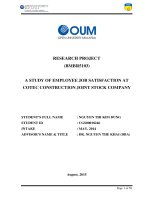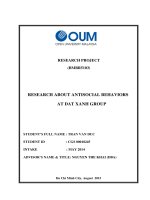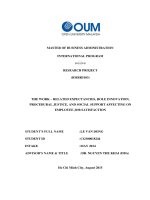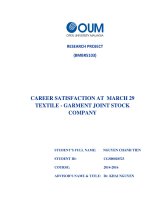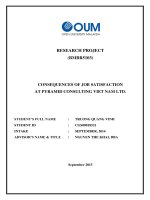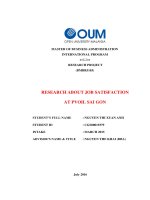Research about job satisfaction at thanh cong textile garment group
Bạn đang xem bản rút gọn của tài liệu. Xem và tải ngay bản đầy đủ của tài liệu tại đây (989.56 KB, 62 trang )
RESEARCH PROJECT
(BMBR5103)
RESEARCH ABOUT JOB SATISFACTION AT
THANH CONG TEXTILE & GARMENT GROUP
STUDENT’S FULL NAME
STUDENT ID
INTAKE
ADVISOR’S NAME & TITLE
: TRAN VAN LOC
: CGS00019898
: SEPTEMBER, 2015
: DBA. NGUYEN THE KHAI
March 2017
Advisor’s assessment
............................................................................................................................................
............................................................................................................................................
............................................................................................................................................
............................................................................................................................................
............................................................................................................................................
............................................................................................................................................
............................................................................................................................................
............................................................................................................................................
............................................................................................................................................
............................................................................................................................................
............................................................................................................................................
............................................................................................................................................
............................................................................................................................................
............................................................................................................................................
............................................................................................................................................
............................................................................................................................................
............................................................................................................................................
............................................................................................................................................
............................................................................................................................................
............................................................................................................................................
Advisor’s signature
DBA. NGUYEN THE KHAI
ACKNOWLEDGEMENT
I would first like to thank my thesis advisor Dr Nguyen The Khai. The door to Dr
Khai office was always open whenever I ran into a trouble spot or had a question
about my research or writing. He consistently allowed this paper to be my own
work, but steered me in the right the direction whenever he thought I needed it.
I would also like to thank the management and HR team in Thanh Cong
Textile/Garment Group who were involved in the validation survey for this research
project. Without their passionate participation and input, the validation survey could
not have been successfully conducted.
Finally, I must express my very profound gratitude to my family for providing me
with unfailing support and continuous encouragement throughout my years of study
and through the process of researching and writing this thesis. This accomplishment
would not have been possible without them.
Thank you.
Tran Van Loc
Contents
ABSTRACT .............................................................................................................1
PART ONE: INTRODUCTION ............................................................................2
Introduction of Thanh Cong Group ..................................................................2
History ................................................................................................................2
Company profile ................................................................................................4
Vision, Mission and Core Values .....................................................................5
Organization Structure .....................................................................................6
Research Problem Statement .............................................................................7
Research Objectives ............................................................................................8
Research Scope ....................................................................................................8
Significances of research .....................................................................................9
Limitation of research .........................................................................................9
Structure of the research ..................................................................................10
PART TWO: LITERATURE REVIEW.............................................................11
Definition of constructs .....................................................................................11
Job Satisfaction................................................................................................11
Supervisory Support .......................................................................................12
Developmental Experiences ...........................................................................12
Goal and Process Clarity ................................................................................13
Job Role Discretion .........................................................................................13
Discussing relationship of the constructs ........................................................14
Hypotheses (H) ...................................................................................................17
Research Model .................................................................................................18
PART THREE: RESEARCH METHODS .........................................................19
Data collection ....................................................................................................19
Design survey template for data collection ...................................................19
Data collection progress ..................................................................................28
Data analysis ......................................................................................................28
PART FOUR: RESULT .......................................................................................29
Cronbach’s Alpha ..............................................................................................29
Cronbach’s Alpha standard applied .............................................................29
Cronbach’s Alpha of constructs ....................................................................30
Descriptive Statistic ...........................................................................................32
Correlation Coefficient .....................................................................................33
Hypotheses Testing ............................................................................................35
Testing result ...................................................................................................36
PART FIVE: CONCLUSION ..............................................................................38
Contribution .......................................................................................................38
Practical implications ........................................................................................39
Limitation and suggestion for further research .............................................39
REFERENCES ......................................................................................................40
APPENDIX ............................................................................................................43
Appendix 1: Survey ...........................................................................................43
Appendix 2: Presentation .................................................................................53
LIST OF FIGURE
Figure 1: Company Organization Structure
6
Figure 2: Research Model
18
LIST OF TABLE
Table 1: Thanh Cong Group at a Glance
4
Table 2: Job Satisfaction Scale
20
Table 3: Supervisory Support Scale
22
Table 4: Development Experiences Scale
23
Table 5: Goal and Process Clarity Scale
24
Table 6: Job Role Discretion Scale
27
Table 7: Cronbach’s Alpha Internal Consistency
30
Table 8: Cronbach’s Alpha Job Satisfaction
30
Table 9: Cronbach’s Alpha of Supervisory Support
30
Table 10: Cronbach’s Alpha of Developmental Experiences
31
Table 11: Cronbach’s Alpha of Goal and Process Clarity
31
Table 12: Cronbach’s Alpha of Job Role Discretion
31
Table 13: Descriptive Statistic
32
Table 14: Correlation Coefficient
33
Table 15: Model Summary and Coefficient
35
Business Research Methods
Page 1 of 56
ABSTRACT
Having invested time and resources in selecting, training and appraising employees,
the employer naturally wants its employees to stay with the firm. Unfortunately,
keeping good employees can be challenging for the organization and managers.
Through various empirical studies, it is found that Job satisfaction (JS) is one of the
important aspect determining employee’s retention and talent development for
organization. This study aims to explore the impact of Supervisory Support,
Development Experiences, Goal and Process Clarity and Job Role Discretion on Job
Satisfaction at Thanh Cong Textile & Garment Group.
In order to answer the research questions, an exploratory qualitative method was
employed with source data was collected from offline surveys with 500 employees
at Thanh Cong Group to collect their ideas and feedbacks about Job Satisfaction. To
reach the purpose of the research and support the Company HR strategies,
interviewees are all staffs from junior, middle and senior level and have certain
experiences in their own professions. The collected data were statistically analyzed
by software SSPS version 22 to give us an overview of relationship and impact of
four factors: Supervisory Support, Development Experiences, Goal and Process
Clarity and Job Role Discretion on Job Satisfaction.
We hop the research’s findings would help the company managers in implementing
HR systems and procedures, employees' competency, motivation and performance.
Keywords: Job Satisfaction, Supervisory Support, Development Experiences, Goal
and Process Clarity, Job Role Discretion.
Student: Tran Van Loc
Business Research Methods
Page 2 of 56
PART ONE: INTRODUCTION
Introduction of Thanh Cong Group
History
Thanh Cong Group is a typical enterprise with long history in Vietnam textile
industry. The group has gone through ups and downs with both failures and
achievements:
1967 – 1975 Foundation
Started as a small private textile workshop with 500 employees which was
named “Tai Thanh Ky Nghe Det” with knitting and dyeing.
Main products: Oxford, Poly Soir, Sanderep…consumed mainly in the south
Vietnam and Cambodia
1976 – 1985 Endeavour to survive
Was taken over by the Government and turned into a state-owned enterprise.
First textile enterprise proposed and successfully implemented “ Triangle
Export” model in 1985
1986 – 2005 Invest to develop
Developed to Thanh Cong Textile Company
Invested 55 million USD to increase productivity and improve the quality.
From selling products in domestic market only, Thanh Cong then exported to
many countries in the world
Carried out comprehensive reform in human resources, working style, sales
and marketing as well as costing controlling
Student: Tran Van Loc
Business Research Methods
Page 3 of 56
2006 – 2012 Reform to Integrate and Grow
2006 – 2009: Was important period, Thanh Cong was equitized and changed
official name into Thanh Cong Textile Garment – Investment – Trading Joint
Stock Company. It was listed on Ho Chi Minh Stock Exchange coded TCM.
2010 – 2012: Implemented modern management tools such as Lean System
in production, ERP & BSC in administration, focused on people
development for future growth through internship program.
2013 – 2017 Stabilize and Flying Growth
Build the new knitting factory to expand capacity
Get investment certificate and establish real estate business division
Second CSR Award by Vietnamese and Korean Government
Top 5 “ Typical VN Textile garment enterprise” selected by VITAS
Certificate of excellent performance awarded by Ministry of Industrial and
Trade
Build Thanh Cong Vinh Long factory
Certificate of Top 10 Best Annual Report in Vietnam stock market
Award of the Best 50 listed companies in Vietnam elected by Forbes VN
Award of Ho Chi Minh Typical Enterprise
Student: Tran Van Loc
Business Research Methods
Page 4 of 56
Company profile
Thanh Cong is recognized as one of most dynamic domestic firm in textile industry.
Throughout our history company has strived to maintain core visions and values to
achieve mutually successful partnerships drive the business forward and offer the
highest levels of quality and value.
Partners that share the firm’s vision of quality, integrity and a desire to succeed will
find that Thanh Cong delivers on every level.
In 2015, the group started launching unrelated diversification strategy by investing
on new business fields: Real Estate, Construction and Managing Project, Touring &
Golf Service and Medical Service.
Thanh Cong Group at A Glance
Head office
36 Tay Thanh Street, Tay Thanh Ward, Tan Phu District, Ho Chi
Minh City, Vietnam
Established year
1967
Equitized date
1st July 2006
Main Business Scope
1. Textile and Garment: Manufacturing and trading products of
spinning, weaving, knitting, dyeing and garment.
2. Fashion retail
3. Trademarks: TCM
Market capitalization
1,242 Billion VND (as of Dec 2015)
Number of employees
4,286 (as of December 2015)
Stock exchange
HOSE (Ho Chi Minh Stock Exchange, Vietnam)
(Table 1: Thanh Cong Group at a Glance)
Student: Tran Van Loc
Business Research Methods
Page 5 of 56
Vision, Mission and Core Values
Vision: WHAT WE SEE…
The influence upon the society through our different way of day-to-day
working while our people and business grow up with the integrity and
knowledge
Mission: WHOM WE WORK FOR…
Customers: Who are benefited by our product and service
Investors: Who trust in our integrity and knowledge for their financial gain
Employees: Who become more confident in their lives through the
meaningful contribution
Suppliers: who are satisfied with our fair and transparent deal
Core Values: WHY WE WORK…
Profitability: To Need to maintain the sustainable profit for all the
stakeholders as well as the enhance of the company
Integrity: To try to be integrated in the course of the business
Learning: To consider that our working place is the learning place in terms
of finding talents and cultivating knowledge & character
Serving: To serve our customers as a king and social minorities as a family
with our sincerity & passion
Student: Tran Van Loc
Business Research Methods
Organization Structure
(Figure 1: Company Organization Structure)
Student: Tran Van Loc
Page 6 of 56
Business Research Methods
Page 7 of 56
Research Problem Statement
Textile/Garment is one of important industry in Vietnam. Under current situation, Vietnam
has signed off Free Trade Agreement with US, EU and Asian Countries which have
brought a lot of opportunities for business. However, there are number of challenges as
many of local textile enterprises have not prepared well enough for global competitiveness.
To catch up opportunities from Free Trade Agreement, Textile and Garment
companies from different countries began to expanding their production in Vietnam.
Above context has created high competition in textile labor market. Many of
employees in domestic enterprises resign to seek for better job in FDI companies.
The management of Thanh Cong Group has realized that the company needs to
implement right employee retention strategy in order to avoid high turnover in a
very near future.
The management determined Job Satisfaction is important in increasing employee
retention, especially talent retention.
Therefore, this study aims to synthetize and analyze factors that how these factors
impact Job Satisfaction of employees in company: Supervisory Support,
Development Experiences, Goal and Process Clarity and Job Role Discretion.
The study contributes to Human Resource Management activities in implementing
employee retention strategies. Learning about job satisfactions also gives company
an opportunity to increase organizational commitment of qualified staffs.
Student: Tran Van Loc
Business Research Methods
Page 8 of 56
Research Objectives
The main purpose of this thesis is to investigate the impact of factors as
Supervisory Support, Developmental Experiences, Goal and Process Clarity and
Job Role Discretion on the Job Satisfaction of employees in Thanh Cong group.
Therefore, two research questions need to be answered:
1. How do four factors impact on Job Satisfaction?
2. How do the findings of this research contribute to the organization?
In order to solve these questions and reach the study purpose, two objectives are set.
The first objective is to explain the concept of Job satisfaction, and then four
factors impact on Job satisfaction.
The second objective is through literature review, to explore the relationship of
these factors with job satisfaction.
Then discussing and proposing recommendation for the human resource
management at Thanh Cong Group to develop and implement employee retention
strategy. Also this study will provide knowledge to the managers in company to
manage staff most effectively.
Research Scope
This research is conducted for all employees at Thanh Cong Group, includes:
General Director, Division Directors, Business Unit Managers, Supervisors, and all
staff levels are working in the group. It does not include: Chairman, Board of
Directors, Shareholder, Supervisory Board, and employees are under probation
period or in maturity leave.
Student: Tran Van Loc
Business Research Methods
Page 9 of 56
The research scope is only for employees in Vietnam, which includes 500 staffs of
Thanh Cong Group.
The feedback of employees will be collected to support the research and
improvement in future. There is no intention of reorganizing, restructuring or
replacing any position.
The survey was carried out at Thanh Cong Group from 1st November to 25th
November 2016.
Significances of research
The research helps the management team in Thanh Cong Group has more
understanding the importance of Job Satisfaction.
High job satisfaction may lead to improved productivity, decreased turnover, and
improved attendance, reduced accidents, less job stress and less unionization.
Besides, we hope the study would contribute to Human Resource Management
activities in implementing employee retention strategies. Learning about job
satisfactions also gives company an opportunity to increase organizational
commitment of qualified staffs.
Limitation of research
The research will have some limitations because it was conducted in related data
within Thanh Cong Group. The findings of research are not able to be generalized
for textile industry in Vietnam.
Student: Tran Van Loc
Business Research Methods
Page 10 of 56
Timing is another limitation as the research was conduct in a short period. Besides,
the survey respondents are more qualified and different perceptions about Job
Satisfaction as well as the contents of survey shall be more grammatical errors
because of English - Vietnamese translation progress, it may cause confusion for the
reader when they answer.
Structure of the research
This section will explain briefly how this thesis is structured.
The part 1 is the overall introduction of the organization and the thesis in which
arguments of why doing this research is discussed, followed by identifying research
objectives and research questions, the scope of the study and structure of the
research.
In part 2, the concept of job satisfaction and four factors are explained, then
discussing the relationship of job satisfaction and four factors.
Research method is introduced in part 3. This part deals with methodological
approaches, research design, how to collect and analyze data, and finally discusses
validity and reliability of the research. In part 4 is for statistical data analyzed result.
Part 5 contains the conclusion of the thesis. It summarizes the main content of the
research and findings. After that, theoretical contribution and implications of the
study are given. Lastly, limitations of the research and recommendations for further
studies are presented.
Student: Tran Van Loc
Business Research Methods
Page 11 of 56
PART TWO: LITERATURE REVIEW
Definition of constructs
Job Satisfaction
This measure was originally developed by Quinn and Shepard (1974) and
subsequently modified by Pond and Geyer (1991) and Rice et al. (1991). It uses six
items to measure an employee’s general affective reaction to his or her job without
reference to any specific facets.
Job satisfaction of employees is familiar topic and has been discussed in over 5000
articles (Shakeel & But 2015: 33). Various theories contributed to develop the
definition of job satisfaction. Those theories are based on classical approach and
modern approach. In classical approach, job satisfaction is divided into two group
“theories of needs” and “theories of value”. “Theories of needs” is related to the
needs of a person, while “theories of value” is associated with the expectation of an
individual. Modern approach is based on “Theory of individual differences” in
which job satisfaction is defined as “a perception created by the individual about
the degree of the job environment to satisfy the individual” (Altinoz et al. 2012:
323). Alderfer (1972) in his research about job satisfaction, three groups of needs
were identified including the need for existence, relatedness and growth. The needs
for existence are related to basic material requirements for a human life.
Relatedness needs include social, security and esteem needs. The needs of growth
Student: Tran Van Loc
Business Research Methods
Page 12 of 56
are concerns with the desire for personal development. All those groups of needs
are quite similar to Maslow’s hierarchy. (Westlund & Hannon 2008: 4).
Discussion about job satisfaction from those theories helps to acquire in-depth
understandings of human-being from aspects of needs and desires. While many
authors discussed job satisfaction based on different theories, other authors defined
job satisfaction relating to personal emotions or psychology towards the job.
Supervisory Support
This measure was developed by Greenhaus, Parasuraman and Wormley (1990) to
assess employee perceptions of the extent to which they receive supervisory support
in their job. It includes eights items.
Supportive supervisors care about employees’ career goals, give credit for work
well done, and help employees develop job-relevant skills and competencies. A
supervisor like this can make all the difference in employees’ everyday work
experiences.
Strong supervisor support improves the quality of employment and is associated
with increased job satisfaction, perceptions of a better fit between the employee and
the organization, and reduced employee turnover.
Developmental Experiences
This measure was developed by Wayne, Shore and Liden (1997). It describes the
formal and informal developmental experience a job affords employees. The
measure focuses on the extent to which an organization makes discretionary
Student: Tran Van Loc
Business Research Methods
Page 13 of 56
investments in formal and informal training and development of an employee. It has
four items.
Developmental Experiences is considered as an important factor which has strong
correlation with employee retention, especially talent retention as it plays an
important role for career development of employee.
Goal and Process Clarity
It was developed and tested by Sawyer (1992). It describes two dimension thought
to make up role ambiguity. One dimension describes clarity about a job’s outcome
goals and objectives. The other dimension describes clarity or certainty about the
job process or how it should be performed. This construct has seven items.
Goal clarity can be simply described as leader’s ability to set a clear and specific
objective that all affected parties understand and can work towards achieving. The
important part of this definition is the word “specific.” A very broad or general
goal won't help drive leader or anyone else to succeed. Goal clarity was directed
related to job satisfaction.
Process Clarity in any team is very important to enable the smooth running of the
task. Process clarity was indirectly related to job satisfaction through goal clarity.
Job Role Discretion
This measure, developed by Gregersen and Black (1992), assesses the extent to
which employees believe their job role gives them discretion to make choices about
how and when things are done.
Student: Tran Van Loc
Business Research Methods
Page 14 of 56
The greater an individual’s discretion as to what work gets done, how it gets done,
and by whom, the greater the empowering sense of responsibility the individual
would feel for those decisions. Thus, regardless of the job, role discretion is likely
to increase felt responsibility. Role discretion may be particularly relevant to
internationally assigned employees who are in autonomous roles away from a
parent company’s headquarters (Gregersen & Black, 1992).This constructs has six
items.
Discussing relationship of the constructs
To discuss about through the relationship of Job Satisfaction and four factors:
Supervisory Support, Developmental Experiences, Goal and Process Clarity and
Job Role Discretion, we should understand that Job Satisfaction is a host of factors,
not a single factor. Each of above factor has direct or indirect relation to Job
Satisfaction.
In another word, each of above factor has an impact on related factor of Job
Satisfaction.
Taking Developmental Experiences as an example, this construct is correlated
positively with number of promotion and employee has received. Promotion is one
of important factor of Job Satisfaction.
Supervisory Support and Job Satisfaction
Refer to research article of Dr Jevon Powell (2011), Supervisor support is defined
as the extent to which leaders value their employees’ contributions and care about
their well-being. A leader with high supervisor support is one that makes
Student: Tran Van Loc
Business Research Methods
Page 15 of 56
employees feel heard, valued, and cared about. In specific terms, organizational
research has identified a myriad of positive outcomes association between
supervisory support and related factors of Job Satisfaction, including:
Stronger person-organization fit
Increased organizational citizenship behaviors (OCB)
Improved employee perceptions of organizational support
Improved relationships with employees
In-role and extra-role performance
Reduced job tension
Reduced work-family conflict
There was research conducted by McGilton KS, Hall LM, Wodchis WP and Petroz
U (J Nurs Adm 2007) about the effects of perceived supervisory support provided
by registered nursing staff on job stress and job satisfaction among nurse aides
(NAs) working in long-term care. The results suggest that supervisory support for
NAs is an important determinant of NAs' job satisfaction.
Developmental Experiences and Job Satisfaction
The authors defined developmental experiences (DE) as an individual’s experience
of taking on demanding assignments that offer opportunity for learning and
leadership. The extent to which an assignment brings DE can depend on how the
particular employee views the opportunity in his or her own mind. Developmental
assignments usually share some common features: unfamiliar responsibilities,
Student: Tran Van Loc
Business Research Methods
Page 16 of 56
opportunity to create change, high levels of responsibility, working across
boundaries, and managing diversity.
Developmental experiences were correlated positively with number of promotion
and employee has received, career development…These factors have strong
positive relationship with Jobs Satisfaction.
Goal – Process Clarity and Job Satisfaction
Goal Clarity describes clarity about job’s outcome goal and objective. For
employee, goal is very important to their performance of work. The clearer goal
setting, the easier employee can achieve.
Process Clarity describes certainty about a job’s process or how it should be
performed. Process Clarity has direct relation to Goal Clarity. Employee is unable
to achieve goal of job if the process of job is uncertain.
Learning from concept of Goal and Process Clarity, we see a positive relationship
of with Job Satisfaction. Goals and goal setting strategies are important
determinates of performance and performance related outcomes such as job
satisfaction.
Goal clarity was directly related to Job Satisfaction, and Process Clarity was
indirectly related to Job Satisfaction through Goal Clarity.
Job Role Discretion and Job Satisfaction
The notion of discretion occurs when someone has the freedom and authority to
take action and is aware of this freedom (Finkelstein et al., 2009, p. 26; Hackman &
Oldham, 1975). A definition on discretion in the English Dictionary for Advanced
Student: Tran Van Loc
Business Research Methods
Page 17 of 56
Learners (2001, p. 435) is: “if someone in a position of authority uses their
discretion or has the discretion to do something in a particular situation, they have
the freedom and authority to decide what to do”.
According to above concepts, Job Role Discretion is about discretion given to
employee to make choices and decision to get their job done. In another word, Job
Role Discretion will help employees to get their job done successfully because the
discretion of the job will bring contribution to their decision in jobs: Responsibility,
Flexibility and Creation.
Job Role Discretion has positive correlation with factors which have direct
relationship with Job Satisfaction: Organizational commitment, Job autonomy, and
working condition.
Hypotheses (H)
Base one above discussion of the relationship among constructs, we would propose
four hypotheses as following:
Hypothesis 1 (H1): Supervisory Support is positively correlated with Job
Satisfaction
Hypothesis 2 (H2): Developmental Experiences is positively correlated with Job
Satisfaction
Hypothesis 3 (H3): Goal and Process Clarity is positively correlated with Job
Satisfaction
Hypothesis 4 (H4): Job Role Discretion is positively correlated with Job
Satisfaction
Student: Tran Van Loc
Business Research Methods
Research Model
(Figure 2: Research Model)
Student: Tran Van Loc
Page 18 of 56
Business Research Methods
Page 19 of 56
PART THREE: RESEARCH METHODS
Data collection
Design survey template for data collection
Job Satisfaction
This measure was originally developed by Quinn and Shepard (1974) and
subsequently modified by Pond and Geyer (1991) and Rice et al. (1991). It uses six
items to measure an employee’s general affective reaction to his or her job without
reference to any specific facets. Responses are obtained on a 5-point Likert-type
scale.
take the job
Definitely
Take the job
job
May take the
job
Not take the
whether to take the job you now have,
Likert-type Scale
take the job
If you had to decide all over again
1
Responses are obtained on 5-point
Questionnaires
Definitely not
No
what would you decide?
5
strongly
Recommend
May
Recommend
4
recommend
your employer, what would you
3
recommend
2.
2
at all
Not
should apply for a job like yours with
Not
If a (good) friend asked if he/she
recommend
1
recommend?
1
Student: Tran Van Loc
2
3
4
5
